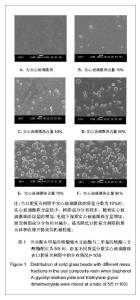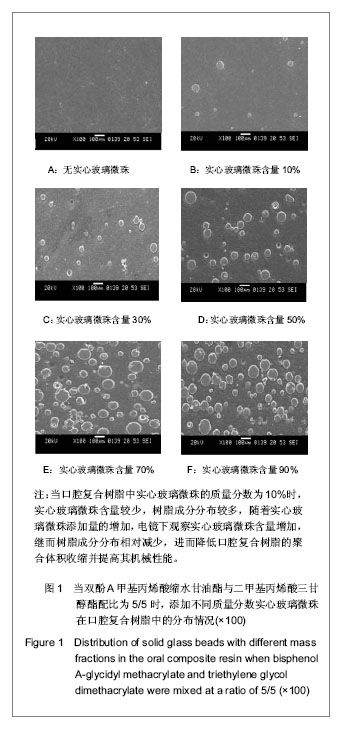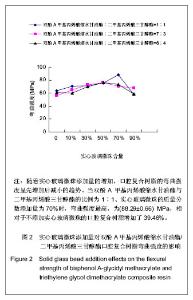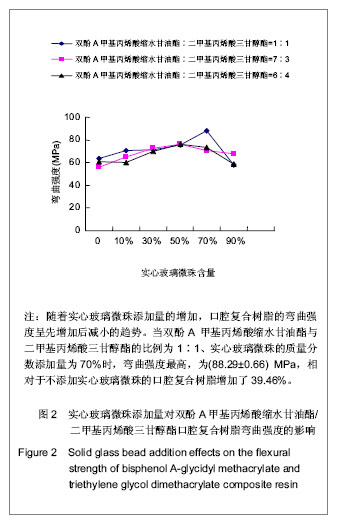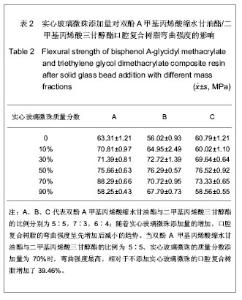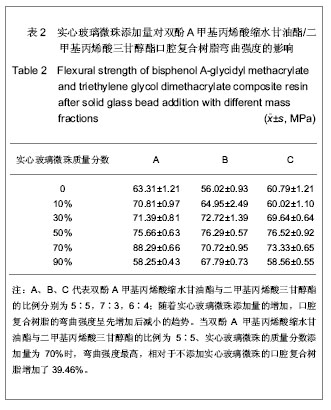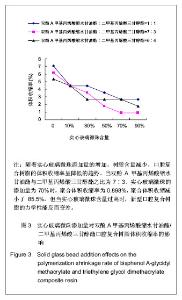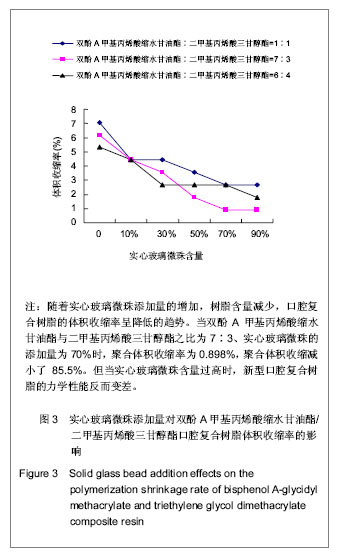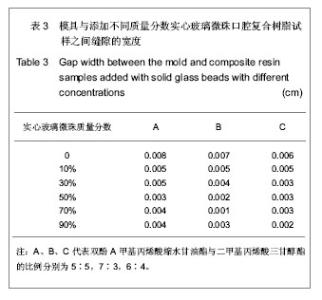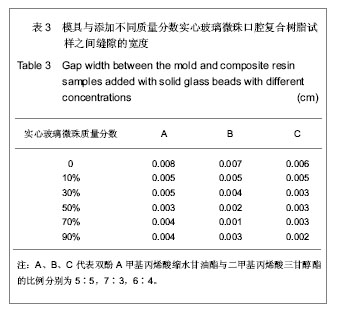| [1] Zhang HQ,Chao YL.Guowai Yixue:Kouqiang Yixue Fence. 2005;32(1):23-27.张怀勤,巢永烈.复合树脂的研究进展[J].国外医学:口腔医学分册,2005,32(1):23-27.[2] Chen ZQ.Beijing:Huaxue Gongye Chubanshe.2004:305.陈治清.口腔生物材料学[M].北京:化学工业出版社,2004: 305.[3] Burke FJ.Evaluating restorative materials and procedures in dental practice.Adv Denc Res.2005;18(3):46-49.[4] Pan LZ,Liu XQ.Guowai Yixue:Kouqiang Yixue Fence. 2006; 5(3): 208-212.潘领战,刘小青.复合树脂基体树脂的研究[J].国外医学:口腔医学分册,2006, 5(3): 208-212.[5] Wang GJ,Fan HB,Song LJ,et al.Xianwei Fuhe Cailiao. 2001; 18(3):11-12.王贵军,樊洪斌,宋六九,等.玻璃微珠在复合材料中的应用[J].纤维复合材料,2001,18(3):11-12.[6] Zhu JN,Zeng LM,Wang Q,et al.Wuhan Ligong Daxue Xuebao. 2006;28(2);1-3.朱纪念,曾黎明,王强,等.玻璃微珠改性PTFE的制备及性能研究[J].武汉理工大学学报,2006,28(2);1-3.[7] Zhang WJ,An YS,Wu JF.Shiyou Huagong Shebei. 2005;34(3): 16-18.张文举,安源胜,吴进菲.玻璃微珠填充改性聚四氟乙烯密封材料性能[J].石油化工设备,2005,34(3):16-18.[8] Bai ZZ,Zhao XL,Luo XF,et al.Re Guxing Shuzhi. 2009;24(2): 32-35.白战争,赵秀丽,罗雪方,等.空心玻璃微珠/环氧复合材料的制备及性能研究[J].热固性树脂,2009,24(2):32-35.[9] Heintze SD,Cavalleri A,Forjanic M,et al.Wear of ceramic and antagonist-a systematic evaluation of influencing factors in vitro.Dent Mater. 2010;2(44):433-449.[10] Huang X,Chen JC,Shen CY,et al.Suliao. 2009;38(4):50-60.黄霞,陈家昌,申长雨,等.氨基酸衍生联酚与聚乙二醇两亲性共聚物的合成与表征[J].塑料,2009,38(4):50-60.[11] Li BQ.Jilin Daxue.2004:35-42.李保泉. 晶须-纳米颗粒牙科复合树脂的研制与性能研究[D].吉林大学博士论文, 2004:35-42.[12] Tantbirvjn D,Veraluis A,Pintado MR,et al.Tooth deformation patterns in molars after composite restoration. Dent Mater. 2004;20(6):535-542.[13] Niu GL,Wang T,Xu HC,et al.Zhongguo Laonian Kouqiang Yixue Zazhi. 2003;1(1):5-8.牛光良,王同,徐恒昌,等.硅烷偶联剂γ-MPS在钡玻璃表面吸附机制的研究[J].中国老年口腔医学杂志,2003,1(1):5-8.[14] Wang YJ,Chen JH,Shen LJ,et al. Kouqiang Yixue Yanjiu. 2007;23(1):57-59.王迎捷,陈吉花,沈丽娟.等.不同类型偶联剂处理对瓷和树脂黏接界面的影响[J].口腔医学研究,2007,23(1):57-59.[15] Xu JP,Wang JJ,Yang C.Heilongjiang Gongcheng Xueyuan Xuebao. 2012;3(1):52-55.许建平,王佳杰,杨闯.SiO2增强口腔复合树脂性能的研究[J].黑龙江工程学院学报,2012,3(1):52-55.[16] Liang JZ,Li GY.Fuhe Cailiao Xuebao. 2000;17(1):19-22.梁基照,李国耀.玻璃微珠表面处理对LDPE复合材料拉伸性能的影响[J].复合材料学报,2000,17(1):19-22.[17] Liu YJ,Feng YQ,He CL,et al. Fuhe Cailiao Xuebao.2006; 23(2): 65-70.刘元俊,冯永强,何传兰,等.玻璃微珠增强硬质聚氨酯泡沫塑料的压缩性能及热稳定性[J].复合材料学报,2006,23(2):65-70.[18] Chung CK,Kim JG,Kim MS,et al.Development of a new photocurable compoite resin with reduced curing shrinkage. Dent Mater.2002;18(5): 174-178.[19] Sideridou I,Achilias DS,Spyroudi C.Thermal expansion characteritics of light-cured dental resins and resin composites.Biomaterials.2004;25(15): 367-369.[20] Tian AF,Zhang XY.Kouqiang Cailiao Qixie Zazhi. 2003;12(4): 192-194.田爱峰,张修银.复合树脂基质的研究进展[J].口腔材料器械杂志,2003,12(4): 192-194.[21] Wang R,Jia AQ,Zhang WY.Guoji Kouqiang Yixue zazhi. 2006; 33(5): 369-372.王蓉,贾安琦,张文云.复合树脂中无机填料的研究进展[J].国际口腔医学杂志, 2006,33(5): 369-372.[22] Xiao WD,He BQ,He PX,et al.Beijing:Huaxue Gongye Chubanshe. 2003:92-100.肖卫东,何本桥,何培新,等. 聚合物材料用化学助剂[M].北京: 化学工业出版社,2003:92-100.[23] Jin W,Li HJ,He CJ,et al.Fuhe Cailiao Xuebao. 2010;27(4): 55-57.金为,李慧剑,何长军,等.空心玻璃微珠填充环氧树脂复合材料力学性能[J].复合材料学报,2010,27(4):55-57.[24] Lu H,Gao DH,Xu HC,et al.Zhongguo Fenti Jishu. 2000;6(3): 1-6.吕环,高东红,徐恒昌,等.牙科复合树脂中无机填料双峰混合体的堆积性能[J].中国粉体技术,2000,6(3): 1-6.[25] Tai ZX,Han Y,Zhang MY,et al.Gaofenzi Cailiao Keuxe yu Gongcheng. 2009;11(11):35-38.邰志新,韩业,张明耀,等. 纳米无机粒子/PC/ASA复合材料的力学性能与微观结构[J].高分子材料科学与工程,2009,11(11): 35-38.[26] Hu XG,Gu XY,Tong Y,et al.Huagong Xinxing Cailiao. 2006; 34(2): 60-67.胡晓刚,顾晓宇,仝毅,等. 改性纳米金刚石增强增韧医用口腔复合树脂的研究[J].化工新型材料,2006,34(2): 60-67.[27] Zhong YX,Ni LX,Wu DC,et al.Yati Yasui Yazhoubingxue Zazhi. 2003;11(6): 331-336.钟玉修,倪龙兴,吴道澄,等.纳米金刚石填料对复合树脂显微硬度、抗压强度的影响[J].牙体牙髓牙周病学杂志,2003,11(6): 331-336. |
